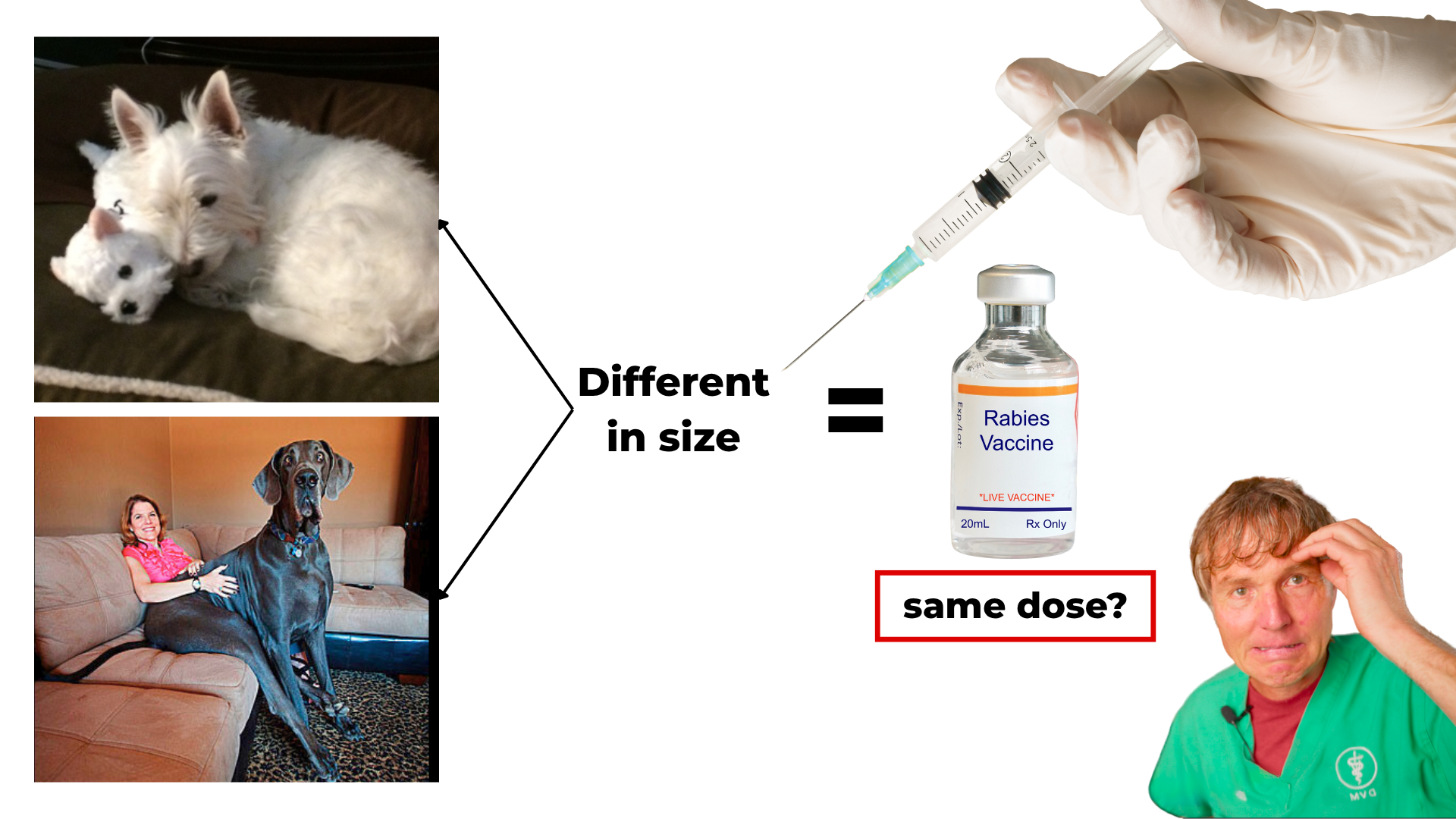Vaccine Volume: Are We Harming Small Dogs and Cats?
![]()
Vaccine Volume: Are We Harming Small Dogs and Cats?
We often hear about vaccine doses being given to pets, but have you ever stopped to consider if the volume of the vaccine is appropriate for small dogs and cats? It turns out, the current approach may not be ideal for all pets, particularly the smaller ones. Let me explain.
Why Choose Dr. Jones’ Ultimate Canine Health Formula for Your Dog?
Dr. Jones’ Ultimate Canine Health Formula is the ideal choice for pet owners who want to support their dog’s overall health and well-being. This comprehensive, all-natural formula promotes a variety of key benefits that will enhance your dog’s quality of life. It supports mobility and joint comfort, ensuring your dog can move freely and comfortably, whether climbing stairs or hopping into the car. The formula also boosts vitality and energy levels, helping your dog stay active and playful.

Why Choose Dr. Jones’ Ultimate Feline for Your Cat?
Dr. Jones’ Ultimate Feline is specially designed to support your cat’s overall health, ensuring they live a long, happy, and active life. This holistic formula works in several ways to improve your cat’s well-being. It alleviates recurrent episodes of diarrhea and vomiting, supports digestive health, and promotes healthy mobility and joint function, especially important for aging cats. This formula offers safe, supportive care, helping to manage aging symptoms. Dr. Jones’ Ultimate Feline is a must-have for your cat’s long-term health and happiness.


The Vaccine Dose Debate
Imagine you have two dogs. One is a large breed, say a Great Dane, and the other is a small, 20-pound poodle like Tula. You take both to the vet for their booster shots, and what do you hear? The vet tells you that both dogs will receive the same vaccine volume. That seems a bit odd, doesn’t it? A Great Dane might weigh 10 times as much as a poodle, yet both receive the same amount of vaccine. Shouldn’t the dosage be adjusted based on size?
If you’ve ever gotten the COVID-19 vaccine, you probably noticed that with the third booster shot, the dose was halved. Why don’t we do the same with our pets?

The American Animal Hospital Association’s Stance
The American Animal Hospital Association (AAHA) states that vaccine doses are not based on the body mass of the animal, but rather on the minimum dose required to immunize effectively. They also claim that reducing the volume doesn’t necessarily reduce the risk of adverse reactions or enhance safety. That sounds like a reasonable argument, right? After all, the AAHA is a trusted expert in the field of veterinary care, and they base their recommendations on the best available research.
But is that the full picture?
The 2005 Study That Changed My Perspective
A 2005 study I came across reveals some important insights. In this retrospective study, researchers analyzed over a million animals and 3 million vaccine doses. The findings were striking: smaller dogs experienced more adverse reactions than their larger counterparts. For instance, a Great Dane they’re less likely to have a vaccine reaction compared to a smaller dog like Tula, the poodle. This actually makes sense. A smaller dog with the same vaccine dose as a large dog is much more likely to experience a stronger reaction because their body mass can’t handle the same volume.
The Problem with Pre-Vaccine Studies
One limitation of earlier vaccine trials is that they often didn’t include enough small or toy-sized dogs. Most studies focused on medium-sized dogs—around 40-50 pounds—and didn’t consider the effects on smaller breeds. This is an issue because it means that the research behind our current vaccine protocols might not be applicable to smaller pets.
While the study claims that adverse reactions are relatively rare—about 0.4% of animals vaccinated—the issue is the escalating incidence of autoimmune-related diseases, including allergies, in pets. The more we stimulate their immune systems with things like vaccines, the more we risk overstimulating them and triggering issues like chronic allergies, excessive licking, scratching, ear infections, and hair loss.
What Does This Mean for Small Dogs and Cats?
It’s clear to me that the current approach may need to change. If a larger dog like a Great Dane gets the same amount of vaccine as a tiny poodle, the smaller dog is at a higher risk of experiencing adverse reactions. In my opinion, we should start considering adjusting vaccine doses based on an animal’s size.
My Recommendations for Small Pets
Rather than following a blanket approach to vaccination, I recommend discussing with your veterinarian whether you can reduce the number of vaccines and the frequency of those vaccines. Focus on giving your pets only the vaccines that are essential for preventing the most common infectious diseases. This approach can be especially helpful for smaller pets, who may be more sensitive to vaccine doses.
If you have a small dog or cat, it’s worth exploring this issue with your vet. In the description box below, I’ll link my suggested vaccine regimen for puppies and kittens, which takes size into account and may be a gentler approach for your small pet.
Thanks so much for reading! If you found this information helpful, please click to subscribe and get notified of my future videos. And don’t forget to click the link below for a free copy of my book.
GRAB A FREE COPY OF MY E-BOOK: Discover Holistic At-Home Remedies

Why Choose Dr. Jones’ Ultimate Canine Health Formula for Your Dog?
Dr. Jones’ Ultimate Canine Health Formula is the ideal choice for pet owners who want to support their dog’s overall health and well-being. This comprehensive, all-natural formula promotes a variety of key benefits that will enhance your dog’s quality of life. It supports mobility and joint comfort, ensuring your dog can move freely and comfortably, whether climbing stairs or hopping into the car. The formula also boosts vitality and energy levels, helping your dog stay active and playful.
Why Choose Dr. Jones’ Ultimate Feline for Your Cat?
Dr. Jones’ Ultimate Feline is specially designed to support your cat’s overall health, ensuring they live a long, happy, and active life. This holistic formula works in several ways to improve your cat’s well-being. It alleviates recurrent episodes of diarrhea and vomiting, supports digestive health, and promotes healthy mobility and joint function, especially important for aging cats. This formula offers safe, supportive care, helping to manage aging symptoms. Dr. Jones’ Ultimate Feline is a must-have for your cat’s long-term health and happiness.
















Hello Dr. Jones,
Thanks for all your videos about how to care our fur babies without harming our pets. I am first time owning Jindo dog, he is 6 months old now, he is well around our family. But he doesn’t do well at Vat office and some strangers. Sometimes, he would behave really gentle. What can I do to easy him to visit Vat smoothly. Alao concern with feeding him with hearearm medication monthly. It says it’s loaded with harmful ingredients and would like to know your opinion. Sincerely pray for your mother in law. Also pray that all your family stay healthy. Again, Thanks for all your videos!!! Helps me so much how to take care little guy.
What do you recommend for puppies shots?
My puppy had a 5 way from the breeder at 8 weeks.
We have her scheduled to get the recombitek C4 & IMRAB 3 rabies at 18 weeks & then we plan on titer testing but should i just skip the 18 week appointment & not do anymore ? I am so torn! Also have a 2.5 yr old Boston Terrier who we are considering neutering but they also require the above rabies shot hes never had one so i am torn on that too if i should skip them all & just find a vet who doesnt require it. Please send your advice thank you!
Here are regimen given by Dr. Jones:
1. Puppies and kittens only need a series of two vaccine boosters, one at 8 weeks then repeated at 12 weeks. I find the most critical time to prevent infectious disease is at this young age. In small kittens and puppies, I prefer to wait until 12 weeks. The traditional third booster in puppies is not necessary. If possible, delay giving the Rabies vaccine until 6 months.
2. Puppies should only be vaccinated for Parvovirus (MLV – Modified Live Vaccines) and Distemper (MLV). Only give Bordetella vaccines if going to a kennel or puppy class. Give Rabies vaccine (KILLED) at 6 months.
3. Kittens should be vaccinated for the respiratory viruses and Panleukopenia (FVRCP – Feline Viral Rhinotracheitis, Calicivirus, Panleukopenia) (MLV). Feline Leukemia (KILLED) vaccine should only be given to ‘high risk’ cats – those in multi -cat households or outdoor cats surrounded by a large cat population. Give Rabies vaccine (KILLED) at 6 months. Ensure that the vaccines are given in the subcutaneous tissue on the lateral sides of the right and left legs.
I gave my puppy at 14 weeks a parvo and distemper vaccine and he is 8 months now. Is it worth giving him a booster or not?
I find that I’m taking a risk everything I give him a shot.
But I also don’t want him to have parvo or distemper. Or is there anything else he needs to be protected from (disease wise)?